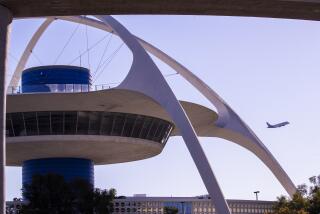Better Eyes for Safer Skies
- Share via
In a series of incidents, U.S. military jets on training missions have flown close enough to civilian passenger jets to trigger the latter’s collision warning alarms. The first occurred Feb. 5 when F-16s from the New Jersey Air National Guard trailed a Nations Air jet at a point 70 miles south of New York’s Kennedy Airport, triggering an alarm that caused the pilot to take evasive action.
Successive incidents over the next five days prompted the Air Force to suspend training flights over much of the nation, though not on the West Coast.
So what goes on here?
All of the incidents are still under investigation by civilian and military authorities. In the first, civilian air traffic controllers seemed unaware that the training area that the Nations Air jet had entered was “hot” or active. And there was poor communication between civilian and military air controllers and the aircraft. The F-16s apparently were not warned about the passenger jet before they closed in to investigate its presence. If the Nations Air crew had been alerted, it might not have taken evasive action.
In other incidents, combat pilots apparently (and unacceptably) strayed outside of their military training areas.
Another factor here has been the slow but invaluable installation of Traffic Collision Avoidance System radar in commercial airliners. TCAS warns pilots of any aircraft flying within a horizontal distance of about 40 miles and a vertical distance of 1,000 feet above and below their aircraft. The system alerts pilots well before the technical definition of a near midair collision (proximity of 500 feet or less).
TCAS is largely credited with reducing the number of near midair collisions between airliners from 1,058 in 1987 to 202 in 1996. Incidents between military and civilian flights were also down, from 23 in 1991 to six last year.
What’s the conclusion? The Air Force was right to suspend training and require pilots to undergo review on joint air space regulations. The spate of incidents may provide a clearer picture of changes that might be needed in those regulations. Meanwhile, civilian passengers should not panic. TCAS has clearly proved its worth and any move to tinker with its sensitivity should be taken with great caution.
More to Read
Sign up for Essential California
The most important California stories and recommendations in your inbox every morning.
You may occasionally receive promotional content from the Los Angeles Times.










